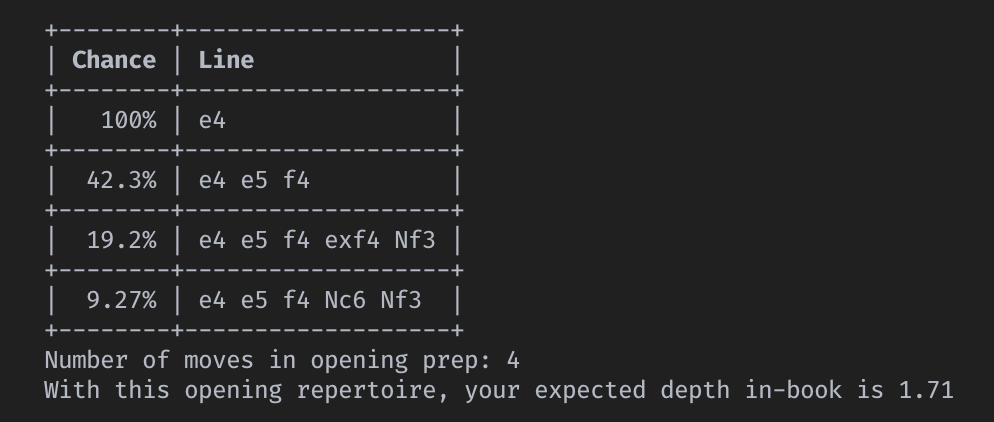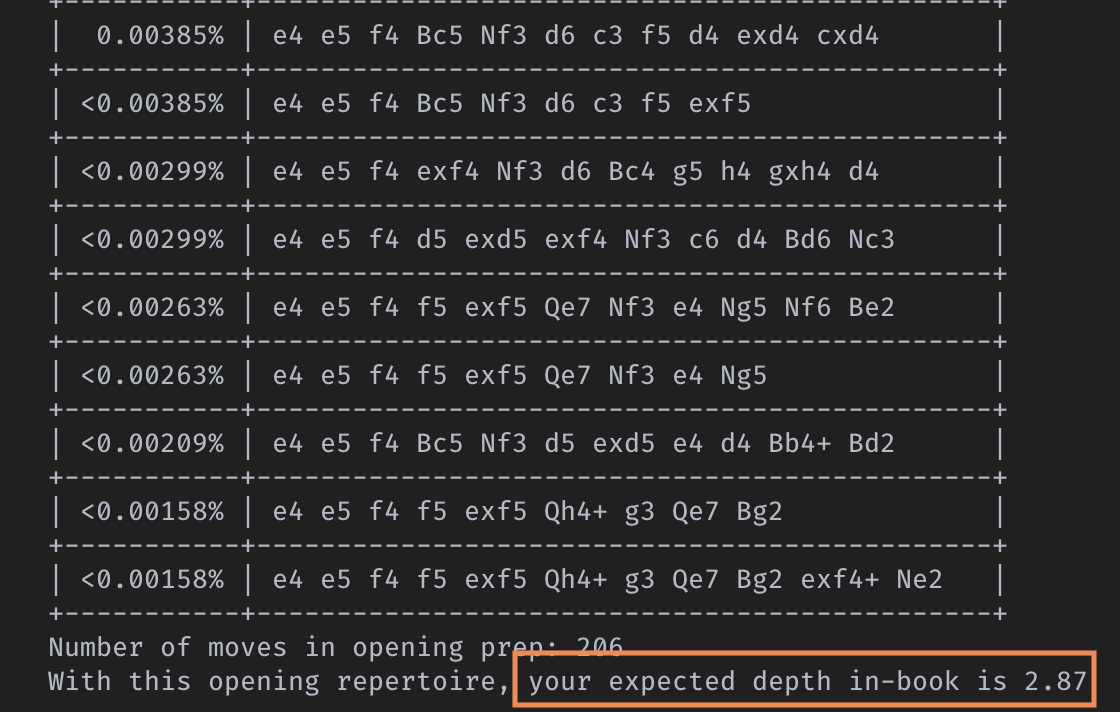How useless is memorizing openings, as an amateur Lichess player?
5 minutes
Jan 27, 2022I recently downloaded Lichess’ database of all December ‘21 games. After using it to generate puzzles for my chess training site, I realized I could also use it to find out something I’ve been wondering a long time: how useless, exactly, is it for me to memorize chess openings?
I’m ~1700 on Lichess, so I chose the ELO range of games for these statistics as 1600-1900. The generated database has 10 million games, and 26 million opening lines, at a max depth of 12 half-moves. Along with the opening database, it takes up most of the space on my computer.
Defining value
There’s kind of a cool thing about having a giant database that says how people
your level play: for every opening line you’re learning, you can figure out the
odds you’ll get to play it in a given game. Take e4, as a trivial example.
You’re 100% likely to be able to play that as white, so that’s a score of 1.
Now let’s say the only response you know is f4, in reply to e5. You only
get to use it if black plays e5, and black does that ~40% of the time, so
that move gets a score of 100% * 40% = 0.4. You can keep going like this for
all moves you have memorized.
The bare minimum king’s gambit
You’re learning the king’s gambit, and you’ve put in the bare minimum effort – this is your entire repertoire:

Let’s see how your “repertoire” stacks up:

You get on average 1.7 moves in-book per game.
The maximum King’s Gambit
Now you’ve been playing with your minimum king’s gambit for a few days, and decide to
take on Nepo’s King’s Gambit course, to demoralize anyone that
dares play e5 against you. This course has 818 moves that it will
drill you on, if you set the depth to 10. That’s clearly ridiculous, even you
can see that, so you buy Chessable Pro and set the depth of the course to 6.
Now you only have to learn 208 moves.
You grind for weeks. 2. … exf4 consumes your free time. Your loved ones are
worried about you. John visits you in your nightmares:

Deep down, you know if you learn all these sidelines, you’ll be the next Magnus Carlsen. Your fellow lichess players will cower in fear. You don’t need tactics, you don’t need endgames, just like you don’t need that f-pawn. So you persevere.
You’ve now memorized all 208 responses, but forgotten your kids’ birthdays and dog’s name. Let’s see where you stand now:

Congratulations, you’ve done it. For your herculean effort, you will now get, on average, 1 move further against your opponents when playing as white. Then on move 3, when you’re out of book, you blunder your light-squared bishop. Should have done some puzzle storm.
But wait, isn’t this just playing with statistics, since your expected depth takes a 58% hit from the unknown of black’s first move?
Alright you’re sort of right. Is the question “in an arbitrary game as white,
how many moves will I know the response to?” or “in an arbitrary game where I
get to play the king’s gambit, how many moves will I know the response to?”. I’d argue
the latter is the more misleading, and the question should actually be “in an
arbitrary game, how many moves will I know the response to?”, but we can
increase the specificity to make you feel better about all the time and money
you’ve spent on Chessable. Here’s what the output looks like assuming you will get 1. e4 e5:

So you’ll play 2.8 moves in-book, after 1. e4 e5 2. exf4, on average. “Hey 2.8 moves isn’t
bad, memorizing 208 moves was totally worth it”, I hear you say. First off,
this is the most optimistic interpretation of your payoff, and you’re still not
even getting 3 moves in-book. More importantly, take a look at that screenshot
again, notice all those lines that are virtually never going to happen. Here’s
a zoomed-out view of a bunch of those lines that are going to happen in less
than 1 in 1000 of your games:

Seeing that the incidence of these lines follows a power law, let’s see how much work you could cut out for a similar return:
Learning 164 moves: 20% less effort, 99.70% of the return, EV: 2.86
Learning 103 moves: 50% less effort, 96.11% of the return, EV: 2.75
Learning 30 moves: 85% less effort, 73.14% of the return, EV: 2.10
Learning 10 moves: 95% less effort, 49.11% of the return, EV: 1.41
You could have eliminated the 50% least likely lines, 104 moves, and still get 96% of the value. You could have knocked out the top 30 moves in a few days, and got 3/4 of the value. Of course, you can’t know exactly what lines those are, without a database like the one I’m using, but in general don’t go more than a few moves deep, and if a move seems weird, check the Lichess opening explorer to see if anyone actually plays that at your level.
If you play games, my PSN is mbuffett, always looking for fun people to play with.
If you're into chess, I've made a repertoire builder. It uses statistics from hundreds of millions of games at your level to find the gaps in your repertoire, and uses spaced repetition to quiz you on them.
If you want to support me, you can buy me a coffee.
855 Words
2022-01-27 04:38 +0000